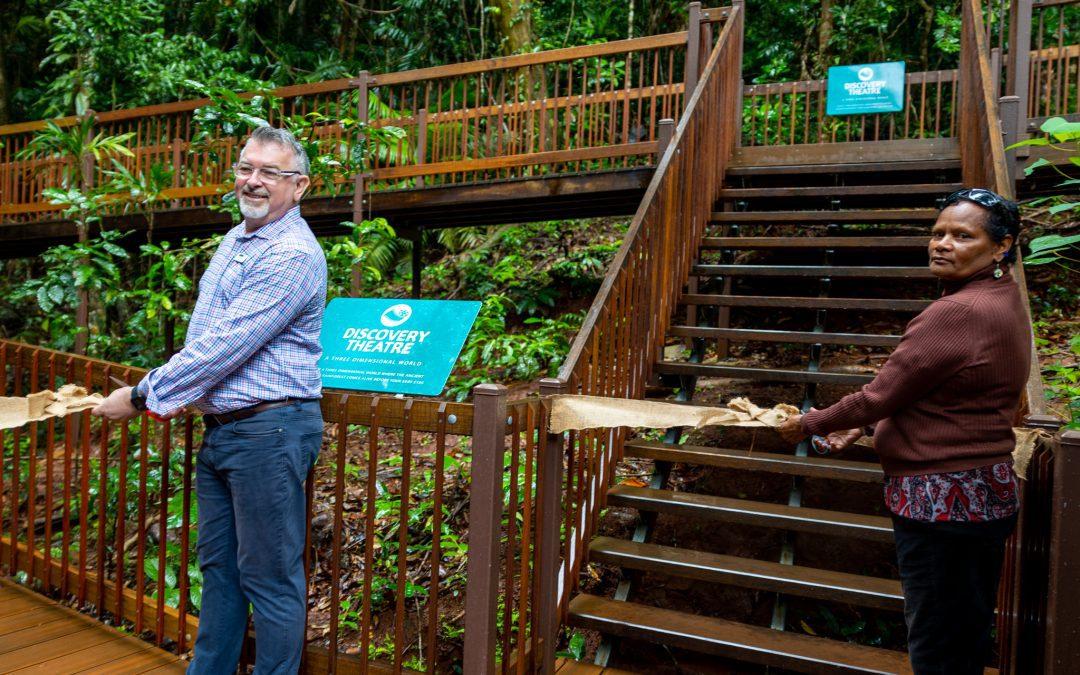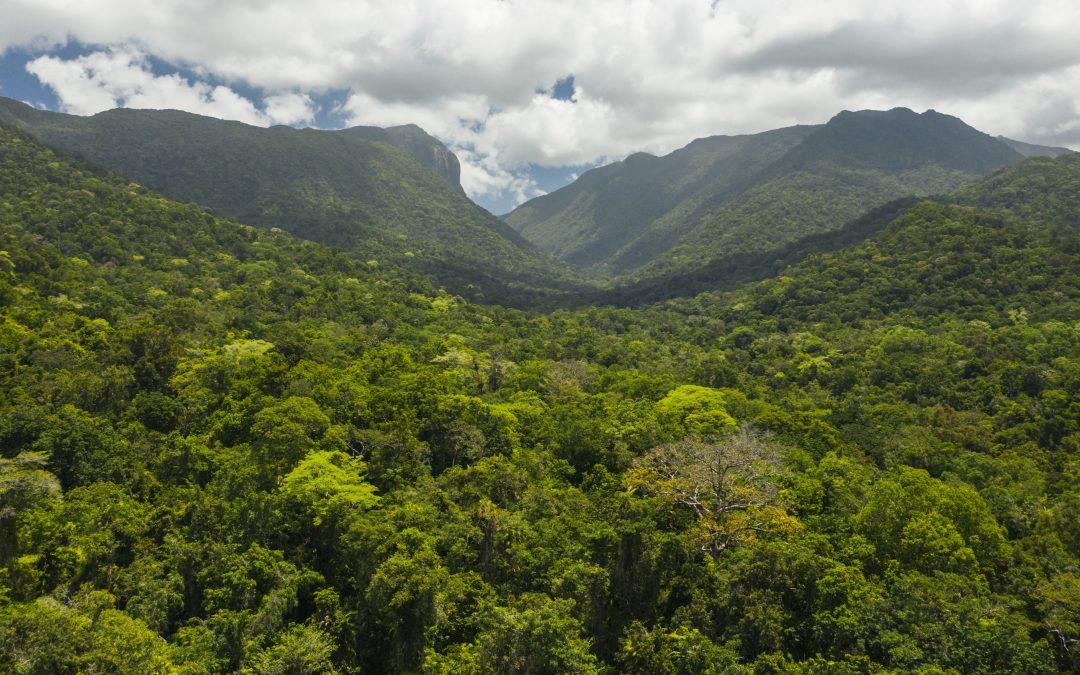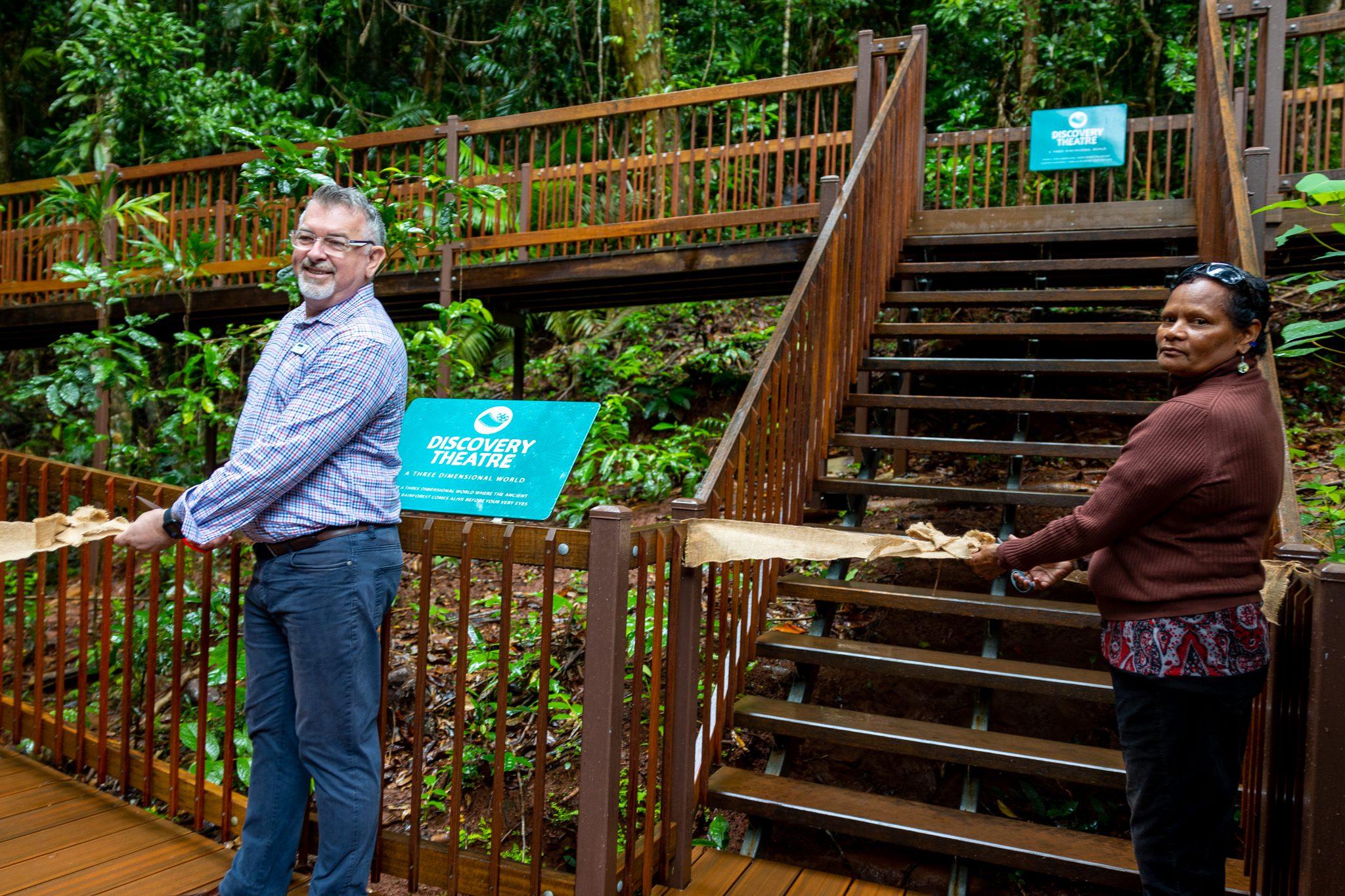×
×

A special 3D hologram attraction that will give visitors an immersive experience of KuKu Yalanji country and culture from the comfort of a new theatre has been officially opened at the Daintree Discovery Centre.
Daintree Discovery Centre manager Abi Ralph said her team was greatly excited about this new addition to the award-winning centre – a unique tourism experience blending immersive technology with firsthand storytelling by a traditional owner.
“We believe we are the only tourism attraction in Australia offering this kind of experience,” Ms Ralph said. “We’ve been working hard to perfect it – and also working hard to keep it under wraps until our opening this month.”
The technology was developed in Queensland by AXIOM Holographics.
Going on country or ‘walkabout’ with KuKu Yalanji man Juan Walker of Walkabout Cultural Adventures provides an insight into the culture and country of these First Nations people.
He explains how traditionally their estate provided for all their needs – it was a medicine chest, tool shed, hardware store, supermarket and church, all in one.
Juan introduces in language and English, the different animals, mostly noctural, and their significance, from the culinary to the mystical, as hologram versions appear almost as if you could reach out and touch them.
He warns of the need to be careful around estuaries and waterways – cue a large saltwater crocodile that swims by, complete with splashing water sound.
Ms Ralph said a former caretaker’s cottage had been repurposed for the new theatre to provide a comfortable setting for the engaging hologram experience. A fully accessible ramp has also been completed to allow access to what is anticipated to be a popular visitor point.
Daintree Discovery Centre incorporates an interpretive centre and a series of boardwalks and aerial walkways, topped off by a canopy tower. These are designed to give visitors the opportunity to experience the sights, sounds and smells of the rainforest at different strata levels while removing the impact of traffic on the forest itself.
The theatre opening will be accompanied by the opening of new interpretive cassowary circuit signage. The upper boardwalk runs through a natural Cassowary Corridor where many of this majestic and ancient creature’s favourite fruits are found.
The signs provide an insight into unique plant species along the boardwalk and the compelling story of how the Cassowary survives in this ancient environment.
Brian Arnold, group general manager of the Gulf Regional Economic Aboriginal Trust (GREAT), which owns Daintree Discovery Centre, said continued investment helped to keep the product experience fresh and maintained the Centre’s position as a must-do activity for visitors crossing the Daintree River.
“Daintree Discovery Centre is recognised as a leader in ecotourism and environmental conservation and maintaining that role is a keen focus of our investment activity,” Mr Arnold said.
For Daintree Discovery Centre opening times, visit www.discoverthedaintree.com.
ENDS
For interview requests, please contact:
Tanya Snelling
Strategic PR
0417 202 663

The spectacular Daintree Rainforest region begins at the Mossman Gorge, in the World Heritage listed Daintree National Park. Only an hour’s drive north of Cairns, the region reaches north through farmlands, valleys and mountains, then across the Daintree River to the ancient rainforests of Cape Tribulation. It is here, one of the few places in the world, where two World Heritage listed areas meet – the Daintree Rainforest and the Great Barrier Reef.
The Daintree Rainforest is exceptional in many ways. It is one of the oldest continuous living tropical rainforests in the world – around 140 million years old, give or take a millennia. It contains one of the most complete and diverse living records of the major stages in the evolution of land plants, particularly in the origin, evolution and dispersal of flowering plants. It also provides a glimpse in the history of local fauna, it’s vastness containing some species older than human life itself.
CULTURAL HISTORY
The Kuku Yalanji people are the Indigenous inhabitants of the land and have a history dating back 50,000 years to the earliest human occupation of Australia. They are true rainforest bama (people), living in complete harmony with their environment. It is part of them, and they are part of it, a notion that is movingly brought to life during an Indigenous guided walking tour of Mossman Gorge. Their traditional country extends from south of Mossman to Cooktown in the north, and Palmer River in the west.
An integral part of the belief system of the Kuku Yalanji, also known as ‘rainforest people’, revolves around nature and the knowledge of its intimate cycles. This information has remained alive and well within the Kuku Yalanji, with present custodians passing on the knowledge of their forefathers, which their forefathers passed on before them (and so on).
Eastern Kuku Yalanji identiy is based on Ngujakura (Dreaming) and is reflected in their living connection to bubu (land) and jalan (sea) and their continued aspiration to conserve and protect country. Waterways are a significant part of Eastern Kuku Yalanji culture as the yirrmbal (rainbow serpent) travels along them. Yirrmbal forms lore and imparts knowledge and decision-making responsibilities which are the basis of traditional management. The estuaries, mangroves, mudflats are breeding grounds for crustaceans and molluscs. The beaches are used by ngawiya (turtles) to lay eggs and the fringing reefs support many varieties of kuyu (fish) and kirrbaji (dugong). Easter Kuku Yalanji is home to many threatened species including beach stone curlews and kurranji (cassowary)
Yalanji clan groups provide advice on the management of World Heritage areas in the Great Barrier Reef and Daintree Rainforest. The Indigenous Protected Areas contain many cultural sites; story places, burial and birthing sites. For this reason, elders request that visitors stay on approved walking tracks, swim in approved places, and do not remove plants, stones or resources, and refrain as much as possible from taking and sharing photographs of these cultural sites.
WORLD HERITAGE STATUS
If you’ve ever wanted to see a real-life Jurassic World, you’ll find some degree of comfort in the Daintree Rainforest – the land time forgot. The region referred to as ‘The Daintree Rainforest’ covers an area of approximately 1,200 square kilometres, or roughly 220,000 football fields. This spectacular region is remarkable for many reasons, but primarily because it’s the oldest continually living, tropical rainforest in the world, boasting an ancient ecosystem with more biodiversity than even the Amazon.
The Daintree region attained World Heritage listing in 1988, following a federal government campaign to push back against logging and agricultural clearing endorsed by the then state government. UNESCO recognised it as an ‘extremely important’ site of rich and unique biodiversity, containing relics of the great Gondwanan forests that covered Australia and parts of Antarctica before the continents split up 50 to 100 million years ago. With over 3,000 plant species, 107 mammals, 368 bird and 113 reptile species, and an actively living and operating indigenous population – now identified as the oldest living culture in the world – this area presents an unparalleled record of the ecological and evolutionary processes that shaped the flora and fauna of Australia.
THE DAINTREE DISCOVERY CENTRE
Before Daintree Discovery Centre was built, there was nowhere for visitors to the region to actually experience the rainforest firsthand, explore the fauna and flora, or begin to understand the historical, biological and social context of this unique wilderness. Unfortunately, those who were venturing into the rainforest through commercially motivated, man-made walking trails were creating unimaginable harm to such ancient areas including Noah Creek and Thornton’s Beach, damaging the fragile vegetation and disturbing the wildlife.
The urgent need for interpretive information – and more particularly for an environmental centre that would allow controlled access to the rainforest, while at the same time protecting the fragility of the environment. So, in 1988, the development of an educational interpretive centre in the Daintree Rainforest began. And it was no mean feat – with no power, no telephone and limited local labour, the odds of success were certainly stacked against the project.
Alongside extensive consultation with the National Parks and Wildlife Service, the local Council, the CSIRO, and various educational and rainforest research centres, the Daintree Discovery Centre was finally completed, and is now an award-winning must-see where visitors can experience the rainforest at every level.
Entry sees visitors equipped with a cornucopia of information, from the comprehensive guidebook to a state-of-the-art audio guide that talks you through the bush-food trail, the cassowary circuit, and the quite realistic Jurassic Forest track, complete with animatronic dinosaurs.
A 125-metre metal aerial walkway keeps things easy, and the climb to the 23-metre-high observation tower tests aerobic fitness, but the views are more than worth the rapid heartbeat. Keep an eye out for cassowaries along the ground-level rainforest boardwalks, often seen exploring the area!
The interpretive Display Centre offers an epic history of evolution starting with the Big Bang Theory moving all the way through the formation of Gondwana, and several interactive information kiosks with touch screen displays to allow easy access to a variety of information suitable for all ages.
The Daintree Rainforest is possibly one of Nature’s greatest playgrounds – make the Daintree Discovery Centre part of your rainforest discovery itinerary when visiting!

















